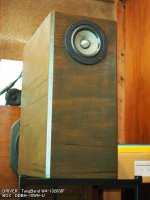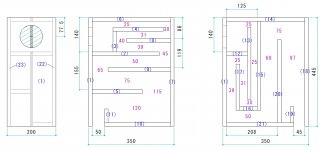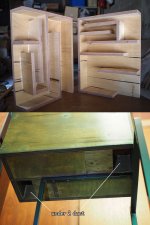I've had these drivers for some years and like them quite a bit, the only thing nagging me being their noticeable beaming, somewhat pronounced for a 4"-class driver IMO.
I've never measured their parameters and always designed for them based on the datasheet. I used to use ARTA/LIMP, but having moved to Linux, I switched to REW. I measured almost everything I have for fun and in order to learn the software. Here's what I got for each of my two units, I post this here for general interest, as this is still a current production model, at the date of this post.
Driver A:
RDC 6.30 ohm
Re 6.11 ohm
Le 0.156 mH
fs 87.0 Hz
Qms 2.823
Qes 0.606
Qts 0.499
Mms 4.57 g
Cms 0.732 mm/N
Rms 0.885 kg/s
Vas 3.38 litres
Bl 5.021 Tm
Eta 0.36 %
Lp (1W/1m) 87.70 dB
Dd 8.52 cm
Sd 57.0 cm^2
Driver B:
RDC 6.30 ohm
Re 6.21 ohm
Le 0.163 mH
fs 87.2 Hz
Qms 2.839
Qes 0.589
Qts 0.487
Mms 4.69 g
Cms 0.711 mm/N
Rms 0.905 kg/s
Vas 3.28 litres
Bl 5.206 Tm
Eta 0.36 %
Lp (1W/1m) 87.72 dB
Dd 8.52 cm
Sd 57.0 cm^2
Datasheet:
NOMINAL IMPEDANCE 8 ohm
DCR IMPEDANCE 6.3 W
SENSITIVITY 1W/1M 88 dB
FREE AIR RESONANCE 75 Hz
FORCE FACTOR, BL 5.31 TM
MOVING MASS 3.99 g
SUSPENSION COMPLIANCE 1134 uMN
EFFECTIVE PISTON AREA 0.0057 M
Levc 0.026 mH
X-max 3 mm
Vas 5.23 Litr.
Qts 0.36
Qms 2.52
Qes 0.42
The good thing is the data is quite consistent between my two units. Fs, Qes and Qts are noticeably higher than factory data. My lower Cms figure might explain the higher Fs. For some reason I read very high Le figures on all my drivers, not sure why. My impedance jig and software are fully calibrated. You can probably disregard my above measured Le.
Edit - I did not actually measure higher Le, the error originated in the driver's seat, who had not yet learned to properly read REW's export formatting. I corrected the values above.
I've never measured their parameters and always designed for them based on the datasheet. I used to use ARTA/LIMP, but having moved to Linux, I switched to REW. I measured almost everything I have for fun and in order to learn the software. Here's what I got for each of my two units, I post this here for general interest, as this is still a current production model, at the date of this post.
Driver A:
RDC 6.30 ohm
Re 6.11 ohm
Le 0.156 mH
fs 87.0 Hz
Qms 2.823
Qes 0.606
Qts 0.499
Mms 4.57 g
Cms 0.732 mm/N
Rms 0.885 kg/s
Vas 3.38 litres
Bl 5.021 Tm
Eta 0.36 %
Lp (1W/1m) 87.70 dB
Dd 8.52 cm
Sd 57.0 cm^2
Driver B:
RDC 6.30 ohm
Re 6.21 ohm
Le 0.163 mH
fs 87.2 Hz
Qms 2.839
Qes 0.589
Qts 0.487
Mms 4.69 g
Cms 0.711 mm/N
Rms 0.905 kg/s
Vas 3.28 litres
Bl 5.206 Tm
Eta 0.36 %
Lp (1W/1m) 87.72 dB
Dd 8.52 cm
Sd 57.0 cm^2
Datasheet:
NOMINAL IMPEDANCE 8 ohm
DCR IMPEDANCE 6.3 W
SENSITIVITY 1W/1M 88 dB
FREE AIR RESONANCE 75 Hz
FORCE FACTOR, BL 5.31 TM
MOVING MASS 3.99 g
SUSPENSION COMPLIANCE 1134 uMN
EFFECTIVE PISTON AREA 0.0057 M
Levc 0.026 mH
X-max 3 mm
Vas 5.23 Litr.
Qts 0.36
Qms 2.52
Qes 0.42
The good thing is the data is quite consistent between my two units. Fs, Qes and Qts are noticeably higher than factory data. My lower Cms figure might explain the higher Fs. For some reason I read very high Le figures on all my drivers, not sure why. My impedance jig and software are fully calibrated. You can probably disregard my above measured Le.
Edit - I did not actually measure higher Le, the error originated in the driver's seat, who had not yet learned to properly read REW's export formatting. I corrected the values above.
Last edited:
For some reason I read very high Le figures on all my drivers, not sure why. My impedance jig and software are fully calibrated.
Good question! Assuming I know what I'm doing, the published specs [Le] upper HF corner due to VC inductance [mH] rolloff:
Fhcm = Re/[pi*[0.26/1000]] = ~77,129 Hz while yours are a minuscule ~ 1,297, 1,290 Hz.
So makes me wonder how the manufacturers determine the HF point.
Dear IG81,
W4-1320SIF is a good driver.
It sounds beautiful regardless of T/S parameters.
I don't use simulators in box designs, so I don't care about T/S parameters.
W4-1320SIF | TAKE FIVE - Helge Lien / YouTube
TangBand W4 1320SIF | TAKE FIVE - Helge Lien - YouTube
W4-1320SIF is a good driver.
It sounds beautiful regardless of T/S parameters.
I don't use simulators in box designs, so I don't care about T/S parameters.
W4-1320SIF | TAKE FIVE - Helge Lien / YouTube
TangBand W4 1320SIF | TAKE FIVE - Helge Lien - YouTube
Attachments
nandappe,
Measuring their T/S did not change my opinion of them. 😉
While I do care about and use T/S parameters, I also like some unusual things like Karlson, RJ, Nagaoka F81 and other such schemes where modern design paradigms are somewhat pushed aside.
My W4-1320SIF are currently in double-chambered reflex (DCR) of 9L, which I built many years ago. Here is an old picture of the box, plus a recent FR measurement.
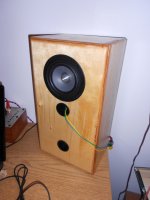
The below response was taken on-axis at 25cm and with an unknown input level, so the SPL level is not absolute.
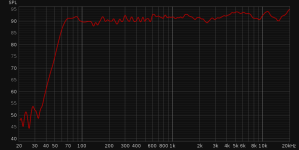
What enclosure do you have your W4-1320SIF in?
Measuring their T/S did not change my opinion of them. 😉
While I do care about and use T/S parameters, I also like some unusual things like Karlson, RJ, Nagaoka F81 and other such schemes where modern design paradigms are somewhat pushed aside.
My W4-1320SIF are currently in double-chambered reflex (DCR) of 9L, which I built many years ago. Here is an old picture of the box, plus a recent FR measurement.

The below response was taken on-axis at 25cm and with an unknown input level, so the SPL level is not absolute.

What enclosure do you have your W4-1320SIF in?
Kudos, as DCR's go, that's an impressively flat response!
I've always measured this driver's on-axis response to be quite flat above it's upper mass corner. I'm possibly minimizing room effects at 25cm away for the lower-end. As I mentionned, it is quite beamy though. Hard to listen as a desktop speaker. I prefer getting a good 2 meters away from them for a wider sweet-spot.
I designed it using the following online calculator.
Advanced Speaker Box Calculator
nandappe,
It's the first time I see an enclosure of this type. If I understand it correctly, it's driving two separate horns? How did you design this? I can see a lot of tweaking could be necessary depending on the approach. I would assume throat impedance would have to be comparable for each section to as to be "driven evenly". The impedance trace clearly shows something more than a single pipe/horn's action is going on there, so I suppose you nailed it!
It's the first time I see an enclosure of this type. If I understand it correctly, it's driving two separate horns? How did you design this? I can see a lot of tweaking could be necessary depending on the approach. I would assume throat impedance would have to be comparable for each section to as to be "driven evenly". The impedance trace clearly shows something more than a single pipe/horn's action is going on there, so I suppose you nailed it!
Dear IG81,
Thanks for the link to the online calculator.
It looks easy to use and I will try to use it.
1320SIF's box, one driver drives two horns.
I make a simple template from the data obtained so far and design according to it.
There is various information in this URL.
[ DIY ] Damp-Duct Back-Loaded Horn Enclosures(BASIC MODELS for Single Driver) - DIY - Loudspeaker | Low-end Speaker Craft
Thanks for the link to the online calculator.
It looks easy to use and I will try to use it.
1320SIF's box, one driver drives two horns.
I make a simple template from the data obtained so far and design according to it.
There is various information in this URL.
[ DIY ] Damp-Duct Back-Loaded Horn Enclosures(BASIC MODELS for Single Driver) - DIY - Loudspeaker | Low-end Speaker Craft
Thanks for the link too, nandappe!
Here's something I built many years ago for FF85WK:
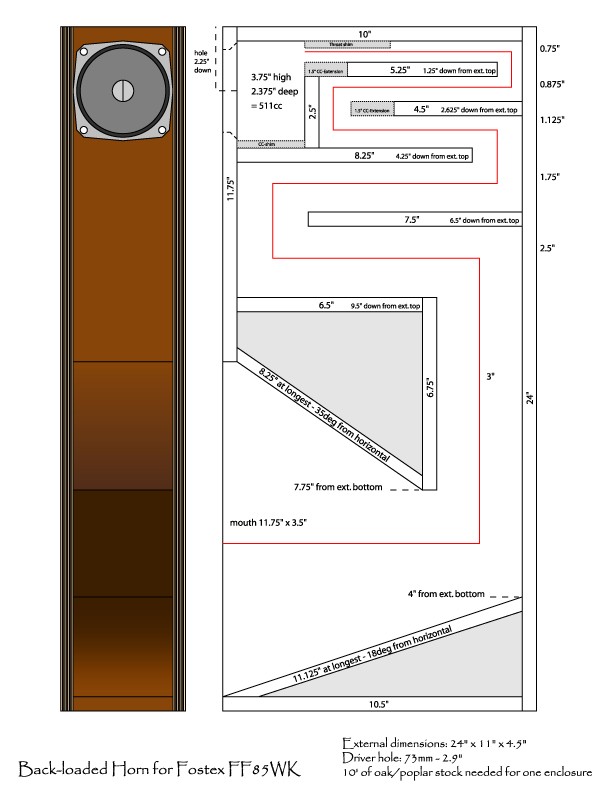
There is much I would change about the design and layout were I to go this route again. I also have a Nagaoka F-81 inspired design I have to refine and might commit to wood sometimes.
Here's something I built many years ago for FF85WK:
There is much I would change about the design and layout were I to go this route again. I also have a Nagaoka F-81 inspired design I have to refine and might commit to wood sometimes.
Dear IG81,
FF85WK cannot drive a long horn, so I use a short horn.
F-81 (Slim Eight) is too big for 3".
Dear gaborbela,
I have never heard W4-1337, what is the sound like?
FF85WK cannot drive a long horn, so I use a short horn.
F-81 (Slim Eight) is too big for 3".
Dear gaborbela,
I have never heard W4-1337, what is the sound like?
Dear IG81,
FF85WK cannot drive a long horn, so I use a short horn.
F-81 (Slim Eight) is too big for 3".
My design is of F-81 inspiration, but is quite a bit shorter, even if still long by any standards, at 224cm, more so than even an "optimal" BiB for this driver, which goes back to Nagaoka Tetsuo as I understand. 🙂
nandappe; Dear gaborbela said:At first I ordered the bamboo cone, after I decided to return to exchange to the titanium cone. I think I made a mistake and of course it cost more to.
Unfortunately I did NOT had both pair at the same time to compare them. The titanium has more mid-range and highs.
A bit too much metallic sound to my taste (without an enclosure).
Reason I exchanged them because I have a pair Visaton AL 130 5" Aluminium cone, I love those a lot, of course they are not a full-range drivers.
The tang Band compare to the Visaton NOT the same category (quality).
I will try build something from the TB and use it as a home theater speakers if I will not be satisfy with their sound.
Regarding the W4-1337, looking at the published frequency response, we see a sizeable rise in output above 10kHz. If I assume the cone and phaseplug shape is similar enough to the W4-1320's cone, it might actually be good as it brings up the in-room power response, which is lacking on the W4-1320.
The second reason I swapped the Bamboo cone to Titanium. Also in the base a bit better based on the data.
The bamboo out of the box the sound wast like full-rage to me, the titanium a bit overboard. Again this listening test was made with out without any enclosure based on my experience. Originally I wanted the Visaton TI 100 titanium driver 🙂 but that is horrible expensive to me.
I wanted to build (DIY) the Topaz project. My opinion the TB driver is not worthies to build such a complex enclosure like the Topaz.
The bamboo out of the box the sound wast like full-rage to me, the titanium a bit overboard. Again this listening test was made with out without any enclosure based on my experience. Originally I wanted the Visaton TI 100 titanium driver 🙂 but that is horrible expensive to me.
I wanted to build (DIY) the Topaz project. My opinion the TB driver is not worthies to build such a complex enclosure like the Topaz.
Attachments
- Home
- Loudspeakers
- Full Range
- Tang Band W4-1320SIF T/S parameters

